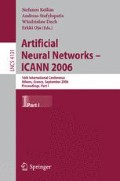Abstract
In this paper, we introduce an enhancement to the Neurosolver, a neuromorphic planner and a problem solving system. The enhanced architecture enables contextual learning. The Neurosolver was designed and tested on several problem solving and planning tasks such as re-arranging blocks and controlling a software-simulated artificial rat running in a maze. In these tasks, the Neurosolver learned temporal patterns independent of the context. However in the real world no skill is acquired in vacuum; Contextual cues are a part of every situation, and the brain can incorporate such stimuli as evidenced through experiments with live rats. Rats use cues from the environment to navigate inside mazes. The enhanced architecture of the Neurosolver accommodates similar learning.
Access this chapter
Tax calculation will be finalised at checkout
Purchases are for personal use only
Preview
Unable to display preview. Download preview PDF.
References
Bieszczad, A., Pagurek, B.: Neurosolver: Neuromorphic General Problem Solver, Information Sciences. An International Journal 105, 239–277 (1998)
Newell, A., Simon, H.A.: GPS: A program that simulates human thought. In: Feigenbaum, E.A., Feldman, J. (eds.) Computer and Thought. McGrawHill, New York (1963)
Burnod, Y.: An Adaptive Neural Network: The Cerebral Cortex. Masson, Paris (1988)
Laird, J.E., Newell, A., Rosenbloom, P.S.: SOAR: An architecture for General Intelligence. Artificial Intelligence 33, 1–64 (1987)
Nillson, N.J.: Principles of Artificial Intelligence. Tioga Publishing Company, Palo Alto (1980)
Deutsch, M.: The Effect Of Motivational Orientation Upon Trust And Suspicion. Human Relations 13, 123–139 (1960)
Hodges, H.: Maze Procedures: The Radial-Arm And Water Maze Compared, Cognitive Brain Research 3, pp. 167–181. Elsevier, North-Holland (1996)
Fenton, A.A., Muller, R.U.: Place Cell Discharge Is Extremely Variable During Individual Passes of The Rat Through The Firing Field. Proc. Natl. Acad. Sci. USA 95, 3182–3187 (1998)
Poucet, B., Save, E.: Attractors in Memory. Science 308, 799–800 (2005)
Fyhn, M., Molden, S., Witter, M.P.: Spatial Representation in the Entorhinal Cortex Marianne. Science 305, 1258–1264 (2004)
O’Keefe, J., Dostrovsky, J.: The Hippocampus as a Spatial Map. Preliminary Evidence from Unit Activity in the Freely-Moving Rat. Brain Research 34, 171–175 (1971)
Pavlov, I.P.: Conditioned Reflexes. Routledge and Kegan Paul, London (1927)
Bitterman, M.E., Lolordo, V.M., Overmier, J.B., Rashotte, M.E.: Animal Learning: Survey And Analysis. Plenum Press, New York (1979)
Kemp, C.C.: Think Like a Rat. Paper for MIT EECS Area Exam (2001), http://people.csail.mit.edu/cckemp/cckemp_place_cells_area_exam_2001.pdf
Hartley, T., Burgess, N.: Models Of Spatial Cognition. Encyclopaedia of Cognitive Science. MacMillan, Basingstoke (2002)
Burgess, N., O’Keefe, J.: Spatial Models of the Hippocampus. In: Arbib, M.A. (ed.) The Handbook of Brain Theory and Neural Networks, 2nd edn. MIT press, Cambridge (2002)
Chavarriaga, R., Strösslin, T., Sheynikhovich, D., Gerstner, W.: Competition Between Cue Response And Place Response. A Model Of Rat Navigation Behavior, Connection Science 17(1-2), 167–183 (2005)
Author information
Authors and Affiliations
Editor information
Editors and Affiliations
Rights and permissions
Copyright information
© 2006 Springer-Verlag Berlin Heidelberg
About this paper
Cite this paper
Bieszczad, A., Bieszczad, K. (2006). Contextual Learning in the Neurosolver. In: Kollias, S.D., Stafylopatis, A., Duch, W., Oja, E. (eds) Artificial Neural Networks – ICANN 2006. ICANN 2006. Lecture Notes in Computer Science, vol 4131. Springer, Berlin, Heidelberg. https://doi.org/10.1007/11840817_50
Download citation
DOI: https://doi.org/10.1007/11840817_50
Publisher Name: Springer, Berlin, Heidelberg
Print ISBN: 978-3-540-38625-4
Online ISBN: 978-3-540-38627-8
eBook Packages: Computer ScienceComputer Science (R0)

